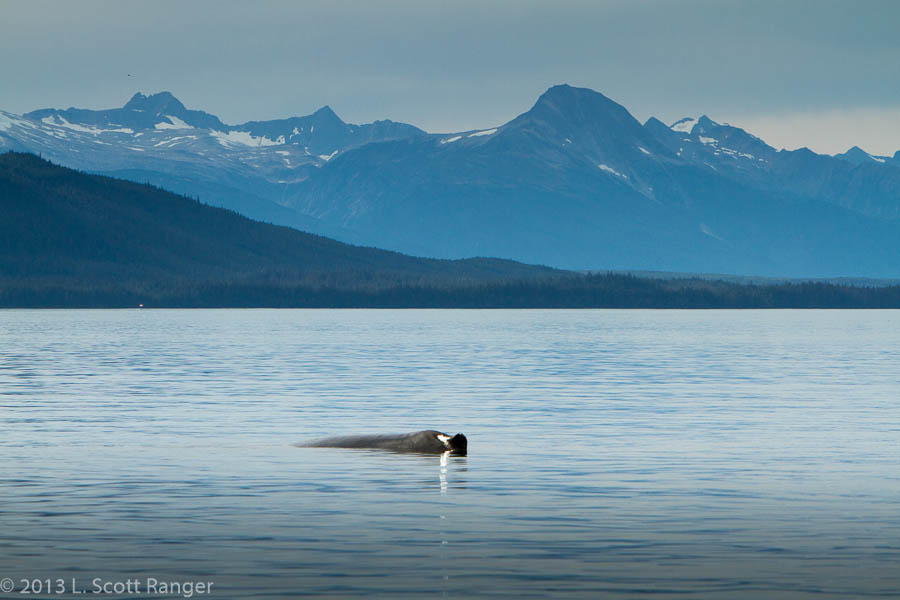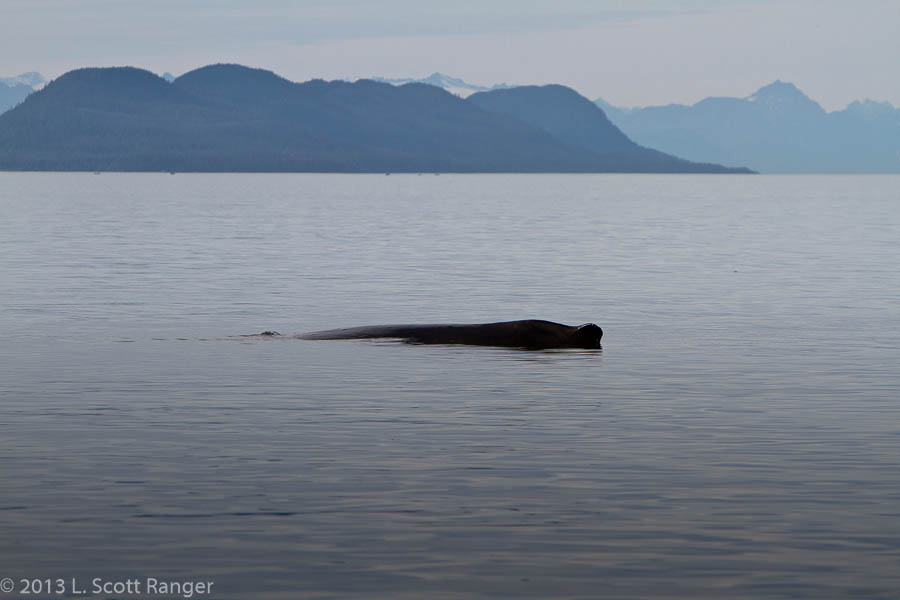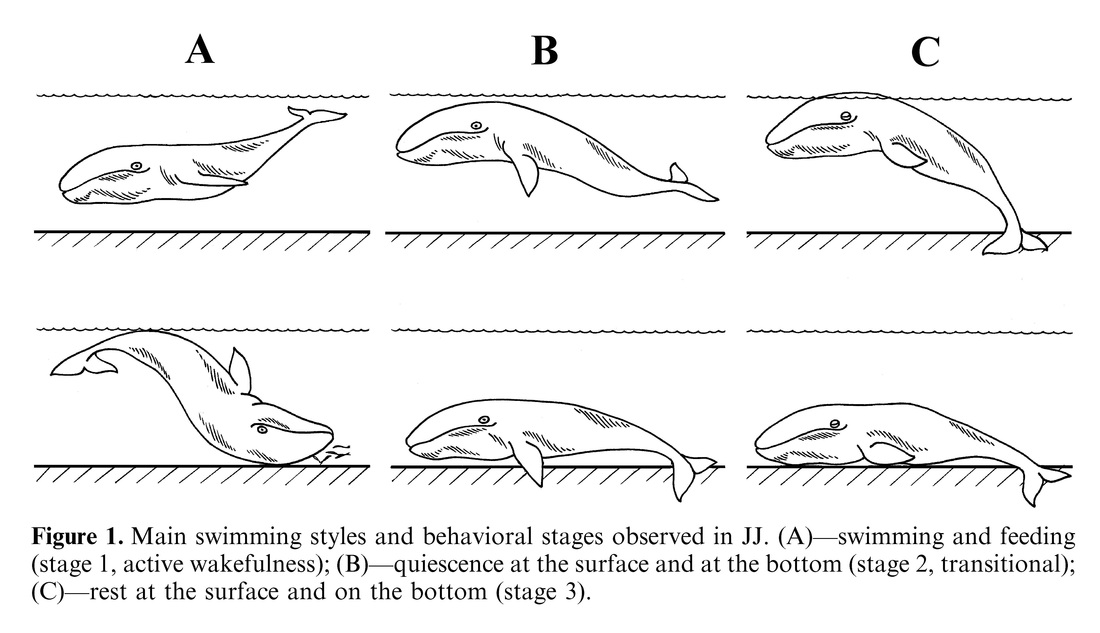Logging
Also called sleeping. At times we’ll come upon a whale, usually alone, that remains nearly motionless for some five to ten minutes (the longest I’ve observed before moving off). It seems reasonable to assume that the whale is sleeping. It will often sink slightly under the surface of the water for a few moments to a few minutes then slowly rise until the blowhole is exposed then exhale and inhale. These breaths are much less forceful, based on the size of the spout and the sound of the rushing air, than those when cruising or involved in some active behavior.
Little is known about large whale sleeping and I have found that of studies of captive dolphin and small whales--
"While sleeping, the bottlenose dolphin shuts down only half of its brain, along with the opposite eye. The other half of the brain stays awake at a low level of alertness. This attentive side is used to watch for predators, obstacles and other animals. It also signals when to rise to the surface for a fresh breath of air. After approximately two hours, the animal will reverse this process, resting the active side of the brain and awaking the rested half. This pattern is often called cat-napping."
[How do whales and dolphins sleep without drowning?]
—have been used to make some extravagant conclusions about larger whales and it seems to be commonly accepted that all large whales utilize unihemispheric sleep. Animal Planet gives this as a (unsupported) fun fact about humpback whales that I have not been able to confirm or refute:
"Humpback whales breathe voluntarily, unlike human beings. Since they have to remember to breathe, researchers believe humpback whales sleep by shutting off half of their brain at a time."
The only scientific observations on large whales that I’ve found comes from a single gray whale calf that was rehabilitated at SeaWorld in San Diego in 1998. The researcher’s conclusion is tentative:
"These findings suggested that, similar to other studied cetaceans (mostly Odontoceti), Mysticeti whales: (1) can sleep both at the surface and at depth; (2) likely have unihemispheric, slow-wave sleep and; (3) might have a small amount of paradoxical sleep, which occurs without pronounced muscle hypotonia and intensive jerks and twitches."
Little is known about large whale sleeping and I have found that of studies of captive dolphin and small whales--
"While sleeping, the bottlenose dolphin shuts down only half of its brain, along with the opposite eye. The other half of the brain stays awake at a low level of alertness. This attentive side is used to watch for predators, obstacles and other animals. It also signals when to rise to the surface for a fresh breath of air. After approximately two hours, the animal will reverse this process, resting the active side of the brain and awaking the rested half. This pattern is often called cat-napping."
[How do whales and dolphins sleep without drowning?]
—have been used to make some extravagant conclusions about larger whales and it seems to be commonly accepted that all large whales utilize unihemispheric sleep. Animal Planet gives this as a (unsupported) fun fact about humpback whales that I have not been able to confirm or refute:
"Humpback whales breathe voluntarily, unlike human beings. Since they have to remember to breathe, researchers believe humpback whales sleep by shutting off half of their brain at a time."
The only scientific observations on large whales that I’ve found comes from a single gray whale calf that was rehabilitated at SeaWorld in San Diego in 1998. The researcher’s conclusion is tentative:
"These findings suggested that, similar to other studied cetaceans (mostly Odontoceti), Mysticeti whales: (1) can sleep both at the surface and at depth; (2) likely have unihemispheric, slow-wave sleep and; (3) might have a small amount of paradoxical sleep, which occurs without pronounced muscle hypotonia and intensive jerks and twitches."
Lyamin, O.I., L.M. Mukhametov, J.M. Siegel, P.R. Manger, & O.V. Shpak. 2001. Resting behavior in a rehabilitating gray whale calf. Aquatic Mammals 27.3, 256–266.
Their extensive bibliography includes no studies on large whales and only a passing reference to a fin whale.
Unihemispheric slow-wave sleep (USWS) is the ability to shut down half of the brain for sleep while the other half remains alert. It is only known from a small number of aquatic mammals and fewer than a dozen species of bird. Paradoxical sleep is usually called rapid eye movement (REM) sleep and is part of the “normal” sleep of humans and most mammals. It gets its name from the curious fact that neuron activity is very similar to waking periods.
We don’t know if humpbacks shut down half of their brain. Based solely upon my observations of logging, I’m skeptical to the point of thinking they are about as asleep—paradoxical sleep—as most mammals with all but the autonomic nervous system being in control of the rising and sinking and coordinated breathing. This system in higher mammals controls much physiology at the subconscious level including heart rate, digestion, respiratory rate, salivation, perspiration, pupillary dilation, urination, and sexual arousal. Watching a large whale slowly rise and sink in exactly the same spot for five to ten minutes seems to me a behavior that could be controlled by the autonomic nervous system. If I watched a similar behavior in a very slowly swimming whale I’d have to serious revisit my thinking. I have not seen this behavior. From all this, I find it an unfounded assumption that humpbacks must be at least partially conscious to rise to breath. How could I prove this? Difficult at best.
Their extensive bibliography includes no studies on large whales and only a passing reference to a fin whale.
Unihemispheric slow-wave sleep (USWS) is the ability to shut down half of the brain for sleep while the other half remains alert. It is only known from a small number of aquatic mammals and fewer than a dozen species of bird. Paradoxical sleep is usually called rapid eye movement (REM) sleep and is part of the “normal” sleep of humans and most mammals. It gets its name from the curious fact that neuron activity is very similar to waking periods.
We don’t know if humpbacks shut down half of their brain. Based solely upon my observations of logging, I’m skeptical to the point of thinking they are about as asleep—paradoxical sleep—as most mammals with all but the autonomic nervous system being in control of the rising and sinking and coordinated breathing. This system in higher mammals controls much physiology at the subconscious level including heart rate, digestion, respiratory rate, salivation, perspiration, pupillary dilation, urination, and sexual arousal. Watching a large whale slowly rise and sink in exactly the same spot for five to ten minutes seems to me a behavior that could be controlled by the autonomic nervous system. If I watched a similar behavior in a very slowly swimming whale I’d have to serious revisit my thinking. I have not seen this behavior. From all this, I find it an unfounded assumption that humpbacks must be at least partially conscious to rise to breath. How could I prove this? Difficult at best.


